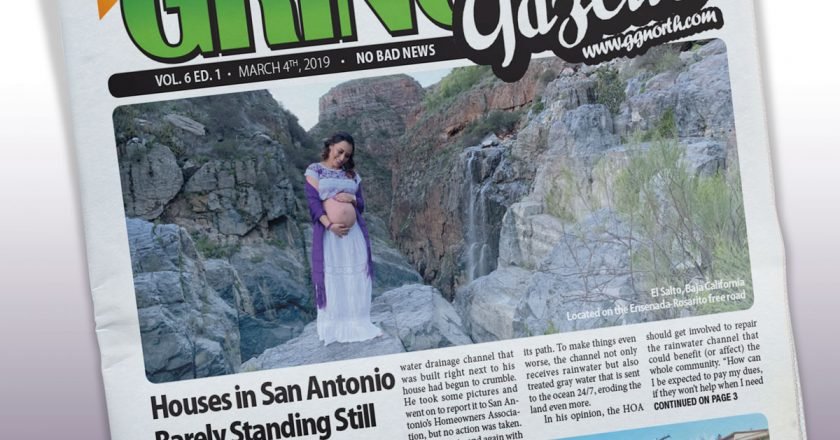


What’s Going On In This Country?
Border emergency. You want to talk about a border emergency? Grab your passport and take a quick trip with me around the world. Look at the tensions between Israel and Syria. India and Pakistan. Iraq and Iran. Colombia and Venezuela. South Korea and North Korea. Now, closer to home, look at this relationship: United States-Mexico.
Thank goodness for good neighbors.
Can we have one of those? Groundbreaking took place Monday near Cancún for a US $312 million mall that will offer major brands. The Grand Outlet Riviera Maya will employ its “malltertainment” concept as nearly half the square footage will be allocated to entertainment attractions. The malltertainment concept consists of offering an all-round experience to the consumer. They even get an ice rink.
Construction started this week and is expected to take 18 months. There will also be a 7,500-seat auditorium, water features, an amusement park, a go-kart track described as the largest in the world and a hot air balloon ride. And three hotels.
Vanishing dolphins. Only 22 vaquita type of porpoises remain in the Gulf of California, a biology professor said yesterday, warning that the species could become extinct within months. The only place they can be found is the upper Sea of Cortez.
How do they know this? It’s a big sea, how can they be sure they’ve counted them all? Because 22 vaquitas were heard over a network of acoustic monitors. Ha! Maybe some vaquita were there and had nothing to say.
Vaquita huggers want more vigilance by the Navy but after angry fishermen who are accidently catching the little dolphins in their nets attacked a ship, Navy vessels have been too scaredy able to stop the illegal fishing.
Who doesn’t like Oxxo? Some residents of Oaxaca claim Oxxo is a threat to Mexico’s heritage. A movement calling itself anti-Oxxo, (less than imaginative but descriptive), erected blockades on several streets to prevent the mega-chain from constructing a new store in front of an elementary school. The group hopes to get all the locations in the city closed down. Members demand that the city government review every location’s construction permits and prohibit the franchise from opening more stores. Whoa, this is serious if they’re demanding permits. No way Oxxo, or any sophisticated chain spreads its tentacles legally.
At least five Oxxos are already located in the city center, which has been designated a World Heritage Site by UNESCO. It is a very cute town.
Electricity is terrorism now? For the second time this year the Federal Electricity Commission (CFE) cut electricity service to the Acapulco water and sewer system, a move described by the water utility as “terrorism.” 600,000 residents were without water, no word on the sewer system, shudder.
The utility had been making daily payments, trying to catch up on the $3.5 million they owe. The day before the “terrorism” against the water/sewer system, they cut off the lights.
Walmart uprising. More than 8,500 Walmart employees in 10 states are seeking a 20% pay increase and a fat bonus. The mainly female cashiers and other low-ranking employees earn on average between US $7 to $7.50 per day, (minimum wage is about $5 a day). They are not enrolled in medical insurance or retirement, their union claims. This is illegal.
In addition, they charge that Walmart doesn’t respect the right to an eight-hour work day, doesn’t pay overtime in accordance with the law, discriminates against pregnant women, and has dismissed workers unfairly. Workers at 121 Walmart stores as well as 56 Sam’s Club outlets and an unspecified number of Bodega Aurrera stores are prepared to walk off the job and in some states they are supported by governors who have acknowledged the “abuse” to which Walmart employees are subjected. Uh, well, why didn’t they stop it then?
The threatened strike follows widespread job actions in several other states where thousands of factory workers have won 20% pay increases and annual bonuses of as much as US $1,650. And they got this within days. However, those were manufacturers who had big contracts to deliver product and would suffer badly if they didn’t deliver. Maybe Walmart can go a few days or weeks without selling a pair of socks.

Luxury Living In the Heart of Tijuana
Tijuana has been historically overlooked by expats moving to Baja who until recently favored almost exclusively beachfront properties. With Tijuana’s rapid business growth and its newly-found vocation as one of the country’s hottest gastronomy hubs, that trend is changing; and now, every day we’re seeing more and more Americans choosing to live in Tijuana to take advantage of its big city feel and especially its closeness to the United States.
Dalias by Hacienda offers a guarded, double-gated community nestled inside one of the most sought-after, and safest communities in Tijuana: Hacienda Agua Caliente. Well-known for its park, and beautifully kept gardens, Hacienda has been able to improve the quality of living of its residents since it opened more than 20 years ago.
Residents here don’t have to worry about the inconsistency on city services as Hacienda provides its residents with its own trash pickup service, street cleaning, public lighting, sewage maintenance, and water pumping as well as gardening of common areas.
Designed by the award-winning “Anonimous” (sic) architectural firm from Mexico City, every home in Dalias makes perfect use of each foot of space.
Two basic models are being offered: Glow and Golden, although variations of each can be chosen. The Glow model features 2,950 sq/ft of construction, two-story, 3-bedroom homes with 3-½ bathrooms, while the Golden model offers 3,800 sq/ft of living space, also offering 3 bedrooms but with bigger spaces, 4 complete bathrooms plus 2 half-bathrooms and a gorgeous game room on the third floor. Both models have fully-equipped service rooms on the lower floor and spacious outdoor patios and carports.
The way these houses have been perfectly designed in a way that takes advantage of natural light in every corner is impressive, and gives each property a special positive feeling.
Its location is unmatchable, being just 15 minutes from malls, the border, Caliente stadium, and Campestre Golf Club. Dalias is right in the middle of everything good going on in Tijuana.
Houses range from $340,000 to $560,000 depending on the model, lot size, and finishes you choose. With less than a year on the market and only 28 properties left, the remaining properties are not expected to last long.
In-house direct financing is available from 30% down, with the rest to be paid in 10 years; qualified individuals can also get a loan from local banks that could be paid in 20 or more years, with a much lower monthly payment.
If you’re up for an interesting living space, right in the middle of one of the fastest growing cities in Mexico, Dalias is definitely the place for you.
To learn more, please visit their website at www.haciendaaguacaliente.com or call them at (664) 397-7621. Mention the code GNHAC01 when you call; that will get you a free $100 USD Starbucks card if you qualify for an appointment.

Is Satan Relocating To La Mision?
You probably haven’t missed it when driving by La Mision in either the free or toll road. How can you? It has a huge horned male creature sticking up in the middle of it, along with several ladies, gargoyles and other satanic statues dancing around.
It is, to say the least, the most interesting and eclectic house around town.
I’m at the gates of the house and I literally didn’t know what to expect; what will the house be like on the inside? What kind of person is the owner?
Once I enter the house and meet Tony Wells, the owner, my whole perception changed. At that point, I realized that my perception of him and the house was created by all the rumors I had heard from people, which were not actually based on reality.
The house on the inside is very well-lit and has beautiful, colored LED lighting all around, with soft Latin music playing on a house-wide Sonos speaker system.
At this point I’m a little confused: wasn’t this a Satanic House?
That is actually the first question I asked Tony and he replied, “Whatever you heard about this house is probably true!” and starts laughing.
I immediately ask about the horned creature that is the most visible sculpture at his house. He tells me its not Satan, but a mix of Pan from the Greek mythology and himself
He takes me to a guest room that has spectacular ocean views and has a fireplace that warms the room. Now, this is starting to actually feel cozy; in fact, this is the opposite of what I had originally thought. I share my feelings with Tony and he laughs, stating “this is where we do the human sacrifices, did I say that out loud?” and he laughs even harder.
After talking to Tony, I noticed that he has heard all the stories about his house, and likes to have fun with it, but I think he likes being controversial the most.
There is no obscure or negative vibe in the house, I even could say that the opposite is true. I toured the rest of the house and noticed the eclectic collection of items in every hall and room within it. I especially noticed the huge collection of chandeliers adorning the house, Tony told me that he invested more than $400K just in chandeliers, and that some are more than 100 years old.
This is definitely not your normal Baja beachfront house; it actually feels a lot like something in between a museum and a home. Every piece of art and item in the house has a story and Tony knows them all. When we get to the master bedroom, he tells me the bed in it was used by the late Elvis Presley and that he got it in an auction for about $450K.
In order to realize his dream, he hired local artists Javier Arellanes, Laura Mas and Javier Filadelfo to build his sculptures, paint them and give them the finishes touches respectively. They work almost every day on projects that “El patron,” as Javier calls Tony, gives them. Even though you won’t find a lot of space to put new things, “El patron” says that the house is still unfinished and still needs some work.
The house also features pieces of artwork from other local artists, every time Tony drives by a place and sees something he likes, he buys it and has it installed in the house. Javier tells me that it would be impossible for them to build every one of the statues in the house itself.
After hanging out with him for a while, engaging in interesting conversation, an idea comes to mind: if this guy is really the devil, we won’t have a chance! He is cool, has a great personality and is kind. There will be long lines to get into his church!
This is not Tony’s first rodeo; he already owns another interesting property in the States, the Alexandra Bordello apartment building in Venice Beach, but that’s in the US where there are lots of rules and regulations to follow, the kind of regulations that wouldn’t allow Tony to completely fulfill his dream project, which is why he decided to build this project in Baja, where he found land that would be the perfect canvas to build his dream home, completely as he imagined it, without limitations.
Of course, not everyone is a fan of his work: many have questioned his style, saying it looks more kitsch than gothic. Everyone has a different opinion about it; some love it while some hate it.
I tell him a story about a post I read on my social media from a Christian friend who said that this was “La Casa del Diablo” or the devil’s house and that he wasn’t even joking. He proceeded to tell me that “Christians are actually my main promoters; they are the ones that have made my house famous so fast. I’ve even had a few knocks at my door from people who say ‘I know what’s going on here!’ – you know – just to complete their sentences a few seconds later with – ‘can we see your house inside?’ – After they meet me and see the house inside, they depart with a whole different idea.”
The property has become a tourist attraction here. In about an hour that I was in there, I saw 10 cars stopping on the road to photograph the house; another 4 groups knocked on the door to see if they could get a glimpse inside the house. Tony says he would like his house to make Baja more interesting for tourists, giving them one more thing to see here in Baja, adding to what we have to offer “It’s my gift to Mexico,” he says.
If you’re interested in getting to know the property, just knock, Tony says he gladly lets people into his house when they ask nicely, although he only does that when he’s there, and he doesn’t live there full-time, so it could be tricky to catch him. Drop by anyway, his staff is always there, and they can tell you if he is there to welcome you into his house.

March 18, 2019 Edition

Houses in San Antonio Barely Standing Still
Home owners in the ocean front community of San Antonio del Mar have been worrying about the integrity of their homes for a couple of years now.
Neighbors on the oceanfront part of Isla Street have seen the back street of their cliff homes being swept off by the sea for several years now; around 40 feet of land in total has fallen into the sea, but recent rains did the most damage, eroding most of the land up to the edge of the structures, jeopardizing the houses.
It wasn’t until 2004 when Marvin noticed that the rainwater drainage channel that was built right next to his house had begun to crumble. He took some pictures and went on to report it to San Antonio’s Homeowners Association, but no action was taken. He did it again and again with no response.

As the land below the drainage channel started to wash out to sea with the rains, the channel that had no support below completely crumbled up to its last remaining part. Marvin was quick to report this to the HOA and city authorities, including the civil protection office, the water company and urban control, but once again, nobody offered any assistance, and just pointed in each other’s directions.
With the rainwater channel destroyed, things have started to get out of control; now every rain takes huge chunks of land behind the homes since all the water that passes through the channel just goes everywhere, washing away everything in its path. To make things even worse, the channel not only receives rainwater but also treated gray water that is sent to the ocean 24/7, eroding the land even more.
In his opinion, the HOA should get involved to repair the rainwater channel that could benefit (or affect) the whole community. “How can I be expected to pay my dues, if they won’t help when I need them?”
HOA fees in San Antonio are $50 dollars every month for houses and $25 for vacant lots and has over 600 properties, although it is well known that not all of the property owners pay their dues.
At the very least, he says he would like to have the HOA on his side in order to pressure the city into doing the repairs.










With more rains expected in the upcoming days, he and his wife Susana are worried that their very lives could be in danger, even after the local civil protection office said a couple weeks ago that at that moment the house didn’t seem to have any structural damage. He is sure that their assessment would probably be different by now, since this last week the floor and walls have started to crack.
Marvin said he has already hired legal counsel in order to figure out who is responsible for repairing the rainwater channel in order to stop the land erosion that is threatening to wash away his dream of a peaceful retirement by the ocean.

March 4, 2019 Edition

Andre Sabatucci Missing. Last Seen In Ensenada
UPDATE FROM HIS FAMILY (2019-03-04): “Andre’s mother has received a lot of phone calls from people who have seen him at different locations. Due to the language barrier it has been though getting addresses of all the locations. As of now we know he is safe, but until his mother locates him herself we would like for this post to be active. Thank you to all who have shared and helped us spread the word. The support we’ve received is insane.”
Andre Sabatucci was last seen in La Bufadora (Ensenada) on January 17, driving his blue Clark Cortez 1966 RV Van. His family and friends are worried about him and would like to know his whereabouts.

Sabatucci is 35 years old, about 190 pounds and measures 5′ 10. He has brown hair, brown eyes and a muscular build.
He is from Huntington Beach. CA, and was on his way to Cabo San Lucas.
If you have any information please contact Jackie Sabatucci, his mother, at US phone number (562) 283-26389.

Rosarito Calendar of Events
February 20, Wednesday, 1 pm; Flying Samaritans Bingo at Popotla Jr (across from El Nido Restaurant). Multiple games/cards and prizes. www.flyingsamaritans.org.
February 26, Tuesday, 8:30 am – 12 pm; 4th Annual Women’s Culture Movement of Rosarito at IMAC (behind Banamex). Featured topics include economic stability, discrimination, and family violence.
March 5, Tuesday, 4 – 6 pm; Wine and Design Mardi Gras Party at De Colores Studio (k40, near Santini’s). Tickets $6 at app.getoccasion.com. Dress for the theme (optional). Paint wine or margarita goblet. Light snacks provided. Facebook.com/ Wine and Design Mardi Gras Party.
March 9, Saturday, 5 – 8 pm; The Sweet Sixx Swingin’ Cabaret Burlesque Review at Hotel Calafia. Live band, cabaret, comedy, flappers, 1920-40 costume contest. Advance tickets online: $15; BGLC Members, $10; $20 at the event. Must be 18! www.SweetSixx.com.
March 15, Friday, 12 – 3 pm; Cruz Roja Rosarito St. Patrick’s Day Luncheon buffet at Charly’s Restaurant (k 37.5). $15 tickets available at the Cruz Roja Rosarito Thrift Store, Monday – Saturday, 10 – 3. All proceeds benefit Cruz Roja Hospital. Facebook.com/ Cruz Roja Rosarito.
March 16, Saturday, 5 – 9 pm; Flying Samaritans presents an evening of Casino Royale. Elegant Dress. Limited tickets, $40. Includes $400 in chips, appetizers. Drink specials. Prizes. Calafia’s Titanic Room (35.5km) All proceeds to benefit Flying Samaritans Rosarito. Tickets at www.flyingsamaritaansrosarito.org, or contact Dean Stalcup @ RDSTALCUP@aol.com; 858-538-5922 or 661-100-6894.
March 17, Sunday, 1 – 4 pm; Cruz Roja Primo Tapia St. Patrick’s Day Celebration at Bobby’s by the Sea. Advance purchase $20 ticket includes entrance, Irish stew, and soda bread. $25 at the event. Tickets available from Board members, Cruz Roja Primo Tapia Thrift Store or PayPal. 50/50, raffle, and Mayan Art Sale. Proceeds to benefit Cruz Roja Rosarito Hospital. www.cruzrojaprimotapia.com.
February 20, Wednesday, 5 pm; Cinema Wednesdays at CEART. “Quisiera ser Grande” (“Big”) directed by Penny Marshall, starring Tom Hanks. Free. Facebook/ CEART Playas de Rosarito; www.icbc.gob.mx; 661-100-6338.
February 21, Thursday, 10 am; Meeting of FRAO (Foreign Residents Attention Office) at Hotel Calafia, Titanic Room. Speaker TBA. Please RSVP to frao.office@gmail.com
February 24, Sunday, 11:30 am; Seniors Supporting (Apoyando) Seniors presents Doug Rye and Winifred Morice in “Love Letters by A.R. Gurney. Location: San Antonio Del Mar, 299 Bahia. Continental breakfast to precede play, Tickets $30 via paypal.me/RCorsaro, or Reggie.Corrsaro@gmail.com. Shuttle available 11:30 – 12:00 for cars parking at the park near the south entrance, 1-626-825-1609.
February 27, Wednesday, 1 pm; Ladies Let’s Lunch! At the Viaje Oyster Bar in the La Quinta Hotel. Facebook.com/ Ladies Let’s Lunch or Facebook.com/ Sandy Eddahbi.
February 27, Wednesday, 5 pm; Wednesdays at the Cinema: “Intensamente” (Intensely), directed by Pete Docter. A girl learns to adapt to living in San Francisco and her new school. Free. Facebook/ CEART Playas de Rosarito; www.icbc.gob.mx; 661-100-6338.
March 9, Saturday, 5 – 8 pm; The Sweet Sixx Swingin’ Cabaret Burlesque Review at Hotel Calafia. Live band, cabaret, comedy, flappers, 1920-1940 costume contest. Advance tickets: $15; BGLC Members, $10; $20 at the event. Must be 18. www.sweetsixx.com.
Every Monday through Thursday, 9am – 12pm; Pickleball at Punta Azul Tennis Center. Cos: $1 court fee per person per day. Organized by Robert Canaan. BYO paddle and ball. Information: Facebook.com/ Rosarito Pickleball
Every Wednesday, 10am – 12pm; Adult painting class at IMAC Rosarito in the main park. Bilingual instructor. 200 peso registration/ 300 pesos per month. IMACRosarito@gmail.com; Facebook/imacrosarito.
Every Friday, 12 – 2 pm; Adult painting class at IMAC Rosarito in the main park. Bilingual instructor. 200 pesos registration/ 300 pesos monthly. IMAC Rosarito@gmail.com; Facebook/imacrosarito.
Every Sunday 4 pm. Cultural Sundays in the park. Local Mexican and American dancers and musicians. At the IMAC in Abelardo L. Rodriguez park, west of Banamex. Facebook IMAC Rosarito. Free.
Every Sunday 2 – 4 pm at the IMAC Central Park (behind the Banamex on Juarez) Dancing for seniors. Salsa and merengue (among others) tunes designed to not throw out a hip. www.facebook.com/IMAC Rosarito
Second Sunday of every month, Pet sterilization by the Baja Spay and Neuter Foundation at the Centro de Diagnostico Clinico Vetrinario, ave. Queretaro #2331-3, Col Cacho, Tijuana. 200 pesos, 661-124-3619, or Robin at www.BajaSpayNeuter.org.
Last Sunday of every month, Jewish Chavurah. Gordon Kane – gordonmkane@gmail.com.
Every Monday, 10:45 am, duplicate bridge at Baja Gold Bridge Club, KM 42 at the Rosarito Beach Christian Church. bajagoldcoastbridgeclub@gmail.com.
Every Tuesday – Rotary Club meets at Rosarito Beach Hotel. 664-376-2620.
Every Tuesday 10am to 11am. Chair Yoga – Rosarito Wellness, Healing, Living at IMAC Park, room 1 in Rosarito (behind Banamex). Improve Balance & Coordination. Receive all the benefits of yoga in a gentle, Healing, Meditative yoga class where a chair is used for support and balance. Bring water, small towel and comfortable clothing. Instructor: Erendira Abel, Certified Holistic Health Specialist. $5 per class, paid at beginning of month. For registration and location: (661) 614-6036 Mexico or (619) 632-2965 US. Email: wellnesshealingliving@gmail.com
Every Tuesday. 9:00 am. Board Meeting for Yo Amo Rosarito at Ortega’s Buffet. See what events are under consideration or volunteer to help plan and run upcoming events.
Every Wednesday, 7:30 – 9:00 am; Tai Chi classes with certified instructor Eugenio Encinas at Galeria Fausto Polanco Rosarito. 350 pesos per month. Alyce: 664-368-6733; Alberto: 661-125-9191.
Every Second Wednesday (except December). 10 am. Friends of the Library meeting at main library of IMAC building next to Abelardo Rodríguez Park. Promotes reading and literacy in Rosarito. www.friendsofthelibrary.com.mx. 661-612-3659.
Second and FourthWednesday, 1 pm; Cruz Roja Primo Tapia Bingo at El Pescador Restaurant. 6 games/ 2 cards for $5. Reduced price menu; Jamesphausmann@gmail.com; 1-623-217-9795.
Every Third Wednesday of the Month (except December), Flying Samaritan’s General Meeting at Villas Del Mar (k 31.5). www.flyingsamaritansrosarito.org; Susansmithz@hotmail.com; 1-858-234-2360; 661-100-6066.
Every Third Wednesday, 10 am, Meeting of Rosarito Sister Cities at City Hall, Fojadores Room, 2nd floor. Information and RSVP: FRAO@Rosarito.gob.mx.
Every Third Wednesday (except December) 1:00 – 4:00 pm, Flying Samaritan’s Outrageous Bingo at Popotla Jr. Restaurant (across from El Nido – formerly California Fresh), Food and Drink specials; free parking behind restaurant; Six games, 4 cards for $10; Karen: kajomc@yahoo.coojm; (US) 1-818-515-0067l (MX) 664-609-3419.
Every Last Wednesday, 11:30 am, Wellness Wednesday Workshop “Intentionally Aging Gracefully” with Erendira Abel at IMAC a Abelard Rodriguez Park (behind Banamex). $6, and pre-registration is required. Info: wellnesshealingliving@gmail.com; (US) 1-619-737-2453, (MX) 661-614-6036.
Every Thursday. 8:30 am. Local Board of Realtors (APIR) meets at Oceana Grill. Good place for buyers or sellers to find a Realtor
Every Thursday, 10:30 am, Learn Spanish “Naturally” with Erendira Abel at Rosarito Beach Christian Church. $5, and pre-registration is required. Info: wellnesshealingliving@gmail.com; (US) 1-619-737-2453, (MX) 661-614-6036.
Every Second Thursday. 10 am. Cruz Roja Volunteers, Rosarito Chapter General Meeting at Popotla Restaurant. www.cruzrojarosarito.org.mx; President: Mary Moreno, miqueridomx@yahoo.com.
Every Third Thursday. 10 am. General Meeting for FRAO, Foreign Residents Assistance Office. Open to the public. Calafia Hotel. Speaker’s presentation. FRAO@Rosarito.gob.mx.
Every Fourth Thursday of the month, 12 pm, Baja Babes, the Rosarito Chapter of the Red Hat Society for ladies over 50 monthly luncheon. Each month a different restaurant. margit@prodigy.net.mx.
Every Saturday, 10:00 am at IMAC Central park. Chess for all ages. www.facebook.com/IMAC Rosarito.
Every First Saturday. 10 am. United Society of Baja California (USBC) general meeting at Casa Blanca Restaurant, Rosarito Beach Hotel. Good info for the English speaking community of charitable, community service and social organizations. www.unitedsocietyofbaja.org. 661-614-1113.
Every First Saturday. Noon-sundown. Open Studio Art Walk, a free tour of galleries in Rosarito Beach Hotel commercial center. Meet artists at work in their studios. pacothepainter@hotmail.com
Every Third Saturday. 1pm. USBC, United Society of Baja California, monthly potluck dinner, at La Maroma sports bar, across from Burger King. Different theme every month. Usually live entertainment. Free. Membership $20 per year.
Every day but one day at a time AA Grupo Gringo meets daily #16 Mar Meditteraneo (two blocks behind Del Mar Beach Club). Saturday, 3:00; Sunday, Monday, Thursday: 10:00 am; Tuesday, Wednesday, Friday: 6:00 pm. Additional meetings in Cantamar (just south of the footbridge) Tuesday and Friday, 10:00 am. 661-614-1678.

Classifieds
OTAY VET VETERINARY CLINIC IN TIJUANA/OTAY AREA, offers vetenary specialty services. Go to www.otayvet.com or facebook. Ph. (664) 623-7999 CA Cell (619) 816-8415. (#26)
MEXICO LIABILITY INSURANCE with legal starting at $84 per year. 800 909-4457 or mexicoinsurance.com OB92215 (#26)
DO NOT RENT FROM TOM S. (AKA. BAJA TOM)IN LA MISION AREA Myself and 6 other tenants have been seriously ripped off and no deposits have been returned on long term rentals. This action is ongoing, take warning. (#TF)
LET ME HELP YOU. Interpreter Spanish-English-Spanish. Mexico drivers license, good in US. Appointments: Doctors, dentist, insurance, spanish lessons. Mary Carmen. From US call 001 52 (661) 1234 135 e-mail: marycarmencisne@gmail.com (#25)
OCEANFRONT 3BD CONDO FOR SALE in Calafia T2, 2BT, beautifully furnished, 4th floor. Only 197K. Ph. 760 815 8957 Annie. (#26)
FOR RENT Ocean Front mini resort in Rosarito County. One Bedroom Suite $800.00 USD. With A 6 month lease, fullly furnished. All utillities included and Direct TV service. Call Salvador at US. 619 467-0310 or Mex. Cell 661 850-4517 Photos: www.Airbnb.com/Rooms/691934 (#TF)
WE WANT TO BUY ocean front homes only. whatsapp# 858-285-9221
HELP WANTED – Opening mail, scanning documents, on-line filing and dog walking. Must be tech-savvy, close to La Jolla de Rosarito and available most days. 8-16 hours/week @ $14/hr. Send job history and intro letter: brett@photosmoviesmore.com
PROFESSIONAL BUSINESS WEBSITES and online marketing services. thebajaadventure@gmail.com 661-131-3131
RENT ENSENADA New house, 3Bedroom, 2Bath, carport, fenced, secure, near Costco, $600, No smoking 646-205-4128 (#4)
FOR RENT fantastic 180degree view, 3bd 2ba detached home. Includes washer, dryer, refrigerator and range. (714) 603 3269. Spanish or English. (#3)












